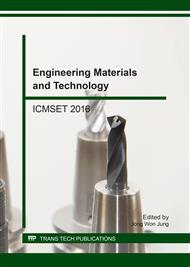[1]
A. M. Schmidt, D. S. Azambuja, Effect of fluoride ions on Ti6Al4V alloy passivation in lactated ringer's serum, Mater. Res.: Ibero-American J. Mater. São Carlos, SP. 6(2) (2003) 227-231.
DOI: 10.1590/s1516-14392003000200018
Google Scholar
[2]
L. Risegari, M. Barucci, L. Lolli, G. Ventura, Low temperature thermal conductivity of Ti6Al4V alloy, J. Low Temp. Phys. 151(2) (2008) 645-649.
DOI: 10.1007/s10909-008-9726-5
Google Scholar
[3]
C. Bathias, K. Elalami, T. Y. Wu, Influence of mean stress on Ti6Al4V fatigue crack growth at very high frequency, Eng. Fract. Mech. 56(2) (1997) 255-264.
DOI: 10.1016/0013-7944(95)00256-1
Google Scholar
[4]
C. Hu, D. Zhang, J. Ren, L. Yang, An overview on cutting force modeling, Adv. Mech. 36(4) (2006) 564-569.
Google Scholar
[5]
Y. H. Jeong, D. W. Cho, Estimating cutting force from rotating and stationary feed motor currents on a milling machine, Int. J. Mach Tools Man. 42(4) (2002) 1559-1566.
DOI: 10.1016/s0890-6955(02)00082-2
Google Scholar
[6]
S. K. Sikdar, M. Y. Chen, Relationship between tool flank wear area and component forces in single point turning, J. Mater. Process. Technol. 128(2) (2002) 210-215.
DOI: 10.1016/s0924-0136(02)00453-3
Google Scholar
[7]
M. Weber, H. Autenrieth, J. Kotschenreuther, P. Gumbsch, V. Schulze, Influence of friction and process parameters on the specific cutting force and surface characteristics in micro cutting, Mach. Sci. Technol. 12(4) (2008) 474-497.
DOI: 10.1080/10910340802518728
Google Scholar
[8]
R. M. Arunachalam, M. A. Mannan, A. C. Spowage, Surface integrity when machining hardened Inconel 718 with coated carbide cutting tools, Int. J. Mach. Tools Manuf. 44(14) (2004) 1481-1491.
DOI: 10.1016/j.ijmachtools.2004.05.005
Google Scholar
[9]
P. Dahlman, F. Gunnberg, M. Jacobson, The influence of rake angle, cutting feed and cutting depth on residual stresses in hard turning, J. Mater. Process. Technol. 147(2) (2004) 181-184.
DOI: 10.1016/j.jmatprotec.2003.12.014
Google Scholar
[10]
C. H. Che-Haron, Tool life and surface integrity in turning titanium alloy, J. Mater. Process. Technol. 118(1-3) (2001) 231-237.
DOI: 10.1016/s0924-0136(01)00926-8
Google Scholar
[11]
D. K. Aspinwall, R. C. Dewes, E. G. Ng, C. Sage, S. L. Soo, The influence of cutter orientation and workpiece angle on machinability when high-speed milling Inconed 718 under finishing conditions, Int. J. Mach. Tools Manuf. 47(12-13) (2007).
DOI: 10.1016/j.ijmachtools.2007.04.007
Google Scholar
[12]
P. Albrecht, New developments in the theory of the metal-cutting process, Part 1: The ploughing process in metal cutting, J. Eng. Ind. ASME. 82(4) (1960) 300-400.
DOI: 10.1115/1.3664244
Google Scholar
[13]
X. B. Liu, M. Soshi, A. Sahasrabudhe, K. Yamazaki, M. Mori, A geometrical simulation system of ball end finish milling process and its application for the prediction of surface micro features, J. Manuf. Sci. Eng. 128(1) (2006) 74-85.
DOI: 10.1115/1.2039098
Google Scholar
[14]
Y. B. Guo, W. Li, I. S. Jawahir, Surface integrity characterization and prediction in machining of hardened and difficult-to machine alloys: a state-of-art research review and analysis, Mach. Sci. Technol. 13(4) (2009) 437-470.
DOI: 10.1080/10910340903454922
Google Scholar
[15]
D. W. Smithey, S. G. Kapoor, R. E. DeVor, A worn tool force model for three-dimensional cutting operations, Int. J. Mach. Tools Manuf. 40(4) (2000) 1929-(1950).
DOI: 10.1016/s0890-6955(00)00017-1
Google Scholar


